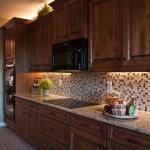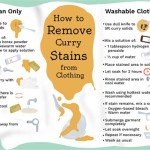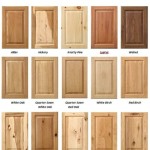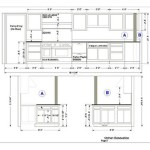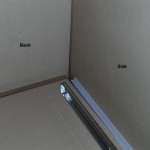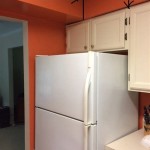Self-Closing Door Hinges for Kitchen Cabinets: Functionality and Selection
Self-closing door hinges represent a significant advancement in cabinet hardware, combining convenience, safety, and longevity for kitchen cabinetry. These hinges are designed to automatically close the cabinet door once it reaches a certain angle, eliminating the need for manual closure and mitigating the risks of partially open doors. This feature can contribute to a safer and more organized kitchen environment while also reducing wear and tear on the cabinet doors themselves.
The incorporation of self-closing hinges into kitchen cabinet design offers a practical solution to common issues like doors left ajar, which can be particularly problematic in high-traffic areas or homes with children or pets. By ensuring consistent closure, these hinges help to maintain a clean and streamlined appearance within the kitchen. Furthermore, the gentle and controlled closing action reduces the likelihood of slamming, which can be disruptive and potentially damaging to the cabinet structure and contents. Their use extends beyond residential kitchens, often found in commercial settings where efficiency and durability are paramount.
The selection of the appropriate self-closing hinge involves careful consideration of several factors, including cabinet door weight, overlay style, and desired level of adjustability. A thorough understanding of these parameters is essential for ensuring optimal performance and a longer lifespan of the hinges.
Understanding the Mechanics of Self-Closing Hinges
The functionality of self-closing hinges relies on a spring mechanism integrated within the hinge body. This spring is compressed as the door is opened, storing potential energy. When the door reaches a specific angle, typically within 20 to 30 degrees of the closed position, the stored energy is released, propelling the door shut. The design of the spring mechanism varies among different hinge manufacturers, influencing the closing speed and overall durability of the hinge. Some designs utilize a single spring, while others incorporate multiple springs for increased closing force or smoother operation. The quality of the spring material and the precision of its construction are crucial determinants of the hinge's longevity and reliability.
In addition to the spring mechanism, many self-closing hinges incorporate a dampening system, often hydraulic or pneumatic, to control the closing speed and prevent slamming. These dampening systems work by resisting the motion of the spring, creating a smoother and quieter closing action. The effectiveness of the dampening system is dependent on its design and the quality of the damping fluid or air used. Over time, the dampening system can degrade, leading to increased closing speed and potential slamming. Regular inspection and maintenance, such as lubrication or replacement of worn components, can help to extend the lifespan of the dampening system and maintain optimal performance.
The geometry of the hinge also plays a critical role in its functionality. The angle at which the self-closing mechanism engages, the amount of force required to open the door, and the overall range of motion are all influenced by the hinge's design. Manufacturers often provide detailed specifications regarding these parameters, allowing for informed selection based on specific application requirements. Understanding the relationship between the hinge geometry and its performance characteristics is essential for ensuring proper installation and operation.
Factors to Consider When Selecting Self-Closing Hinges
Selecting appropriate self-closing hinges for kitchen cabinets requires careful consideration of several key factors. These include the cabinet door weight, the overlay style of the cabinets, the material of the cabinet and door, and the desired level of adjustability. Ignoring these factors can lead to unsatisfactory performance, premature failure of the hinges, or damage to the cabinets themselves.
Cabinet Door Weight: The weight of the cabinet door is a critical factor in hinge selection. Heavier doors require stronger hinges with greater spring force to ensure reliable closure. Manufacturers typically specify the maximum weight capacity for each hinge model. Exceeding this weight limit can lead to premature wear of the hinge mechanism, reduced closing force, and potential sagging of the door. When dealing with heavier doors, it may be necessary to use multiple hinges per door to distribute the weight evenly and ensure adequate support. Determining the actual weight of the door, including any attached hardware, is essential for accurate hinge selection.
Overlay Style: Cabinet overlay refers to the amount the cabinet door overlaps the cabinet frame. Different overlay styles, such as full overlay, partial overlay, and inset, require different types of hinges. Full overlay hinges are designed for doors that completely cover the cabinet frame, while partial overlay hinges are used when the door only partially covers the frame. Inset hinges are used for doors that sit flush with the cabinet frame. Selecting the correct hinge type based on the overlay style is crucial for proper door alignment and functionality. The hinge's crank, which is the offset of the hinge arm, is the key factor in determining compatibility with different overlay styles.
Cabinet and Door Material: The material composition of both the cabinet frame and the door itself influences the type of hinge that's most suitable. Certain types of wood, like hardwoods, can securely hold screws and are less prone to stripping compared to softer materials like particleboard or MDF (Medium-Density Fiberboard). Therefore, selecting hinges with the appropriate screw type and length is crucial for ensuring a lasting and secure attachment. For heavier doors or when working with less dense materials, it may be necessary to use longer screws or reinforcement plates to provide additional support.
Desired Level of Adjustability: Many self-closing hinges offer adjustability features that allow for fine-tuning of the door's alignment and closing speed. These adjustments can be particularly useful for compensating for minor imperfections in cabinet construction or for accommodating changes in humidity that can affect wood stability. Common adjustments include side-to-side, up-and-down, and in-and-out movement, allowing for precise alignment of the door within the frame. Some hinges also offer adjustments to the closing speed, allowing for customization of the closing action to suit individual preferences. Hinges with greater adjustability offer more flexibility during installation and can help to prolong the life of the cabinets by allowing for periodic adjustments to maintain proper alignment.
Types of Self-Closing Hinges
Several types of self-closing hinges are available, each designed for specific applications and offering varying levels of functionality and adjustability. Understanding the different types of hinges can help in selecting the most appropriate option for a particular kitchen cabinet project.
Face Frame Hinges: Face frame hinges are designed for cabinets with a face frame, which is a wooden frame that surrounds the cabinet opening. These hinges typically attach to the inside of the face frame and the back of the cabinet door. Face frame hinges are available in various overlay styles, including full overlay, partial overlay, and inset. They often offer adjustability features for fine-tuning the door's alignment.
Frameless Hinges (European Hinges): Frameless hinges, also known as European hinges, are designed for cabinets without a face frame. These hinges attach directly to the inside of the cabinet box and the back of the cabinet door. Frameless hinges are typically concealed when the door is closed, providing a clean and modern look. They are available in various overlay styles and offer a high degree of adjustability.
Soft-Close Hinges: Soft-close hinges are a type of self-closing hinge that incorporates a dampening mechanism to prevent slamming. These hinges provide a smooth and quiet closing action, reducing noise and preventing damage to the cabinet structure. Soft-close hinges are available in both face frame and frameless styles and offer varying levels of adjustability. The dampening mechanism can be pneumatic or hydraulic, with hydraulic systems generally offering smoother and more consistent performance.
Spring-Loaded Hinges: Spring-loaded hinges rely solely on the spring mechanism for self-closing functionality. These hinges typically offer a more forceful and rapid closing action compared to soft-close hinges. While often more economical, they lack the refined closing action and quiet operation of their soft-close counterparts.
The selection of self-closing door hinges for kitchen cabinets should be based on a comprehensive understanding of the application requirements, including cabinet construction, door weight, overlay style, and desired level of functionality. Choosing the appropriate hinge type can significantly enhance the performance, longevity, and overall aesthetic appeal of kitchen cabinetry.

Cabinet Door Hinges Self Closing Soft Close Rejs Ltd

Soft Close Inset Cabinet Door Hinges Kitchen Hardware

Soft Close Kitchen Cabinet Door Hinge 110 Degree

Kitchen Door Hinge Hardware Cabinet In Steel Soft Close Hinges Self

Furniware 1 2 Overlay Cabinet Door Hinge 15 Pairs 30 Pack Flush Face Mount Cupboard Self Closing Hinges For Decorative Kitchen Brushed Nickel Com

Concealed Hinge Salice Overlay Hinges Thin Door Full Tmhardware Com

Dazone 50 Pack 1 4 Overlay Cabinet Hinges Soft Close Face Frame Kitchen Cupboard Door Half 105 Compact Handware Stainless Steel Com

1 2 Overlay Cabinet Hinges 25 Pairs 50 Pack Black Partial Wrap Hinge Self Closing Door For Kitchen Cabinets Yahoo Ping

1 2 Overlay Self Closing Kitchen Cabinet Hinges Hardware Matte Black

Self Closing Hinge For Es
Related Posts

